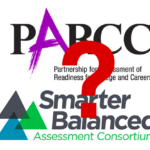
We know that there are two different Common Core-aligned assessment consortia, but what exactly makes them different? In this blog post we review the key elements of Smarter Balanced and PARCC assessments. What makes them similar? What makes them different? Read below the fold for more.
Let’s start with similarities…
Essentially, the two assessment consortia seek to meet the same goal: determining if a student is “college and career ready”. They plan to do so (mostly independent of one another) by providing standardized online assessment resources that assist in identifying a student’s mastery of the Common Core State Standards (CCSS) and the need for additional instruction and remediation.
Both assessments utilize computer-based math and English Language Arts (ELA) assessments designed to evaluate standards-focused math and ELA proficiency. Thanks to the speed of computer-based scoring, most schools will receive student results and reports within several weeks of taking the exam, providing plenty of opportunity to examine the data and determine the next steps for students.
Okay, so what’s the big difference?
PARCC and Smarter Balanced sound pretty similar so far, right? Ahh, not so fast! The two consortia are significantly different in many areas. Let’s take a look at select variants below.
The Member States
The first, and most obvious, difference is that the PARCC and Smarter Balanced assessments will be administered in two separate groups of states. Through the Race to the Top Assessment Program, participating states chose to become member states of either the PARCC consortium or the Smarter Balanced consortium.
For the official listing of PARCC member states – i.e. states administering the PARCC assessments, click here.
For the official listing of Smarter Balanced member states, i.e. states administering the Smarter Balanced assessments click here.
Assessment Sections and Schedule
The two assessment consortia are also taking a slight different approach to their summative and non-summative components:
PARCC:
The PARCC assessment is essentially comprised of four separate testing pieces: two mandatory summative assessments and two optional non-summative assessments.
Summative Assessments (mandatory):
- Performance-Based Assessment (PBA) – Per PARCC, the PBA is intended to be administered roughly three-fourths into the school year. The key functionality of the PBA is to test students’ ability to write in English Language Arts (ELA) and complete multi-step, real-world application problems in math.
- End-of-Year Assessment (EOY) – Per PARCC, the EOY is intended to be administered roughly 90 percent into the school year. The key function of this summative assessment’s is to identify students’ reading comprehension levels in ELA and conceptual understanding in math.
Non-Summative Assessments (optional):
- Diagnostic Assessment – Per PARCC, this assessment is designed to provide an indicator of student knowledge and ability for further needs-based personalization.
- Mid-Year Assessment (MYA) – Per PARCC, the MYA serves a precursor to the mandatory PBA by placing a focus on “hard-to-measure” standards.
Smarter Balanced:
The Smarter Balanced assessments are also broken into two components: a single mandatory summative assessment and optional interim assessments.
- Summative Assessment (mandatory) – Per Smarter Balanced, their summative assessment is split into two sections: a computer-adaptive test (more on that in a sec) and non-adaptive performance tasks. This assessment will be administered during the last 12 weeks of the school year.
- Interim Assessments (optional) – Unlike many of the other assesment components, the schedule of these interim tests is left up to local education officials. The goal is to provide practice and per-summative assessment acknowledgement of a student’s strengths and area of needed reinforcement. The interim assessments also incorporate a mix of computer adaptive testing and fixed-form performance task items.
To be adaptive or to not be adaptive…
The last major difference found between the tests is the computer adaptive testing (CAT) ability (or lack there of). Both assessments utilize technology-enhanced items, however only the Smarter Balanced assessment currently plans to implement CAT within its online tests.
Through Smarter Balanced, each student receives a unique set of assessment items based on previous responses. In a very general sense, if a student gets a response correct, he/she will then receive a more-difficult question designed to test a higher-order thinking task (and vice versa). CAT assessments claim this more-quickly identify a student’s ability level and areas of strength and weakness.
In contrast, PARCC’s Summative Assessments (PBA and EOY) will not be adaptive, instead opting for a fixed-set of questions.
I hope you found this information about PARCC and Smarter Balanced assessments valuable. As we learn more information about the assessments we will continue to post blog posts.
As always, feel free to send the Wowzers Math Team your ideas, stories, questions, and comments via our Facebook page or tweet us at @Wowzers.

0 Comments